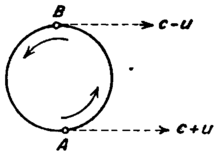The expectation you're asking about is called Emission theory:
obeying the usual laws of Newtonian mechanics, and we expect light to be moving towards us with a speed that is offset by the speed of the distant emitter (c ± v).
If you look at the section entitled Refutations of emission theory, you'll see some of the most concrete examples of how this was shown not to hold true for light.
One convincing argument comes just from looking up at the night sky:
In 1910 Daniel Frost Comstock [1] and in 1913 Willem de Sitter [2] wrote that for the case of a double-star system seen edge-on, light from the approaching star might be expected to travel faster than light from its receding companion, and overtake it. If the distance was great enough for an approaching star's "fast" signal to catch up with and overtake the "slow" light that it had emitted earlier when it was receding, then the image of the star system should appear completely scrambled.

de Sitter's double star argument
Experiments (similar to Michelson--Morley which was already mentioned) can measure photons from the same source travelling both in the same direction of earth's travel, and in the opposite direction of earth's travel. In the world of classical mechanics, one would expect the one launched in the direction of earth's travel to get a fixed distance away from the source faster, but experiments repeatedly show that both travel the same distance in the same time.
Such experiments include that of Sadeh (1963) [3] who used a time-of-flight technique to measure velocity differences of photons traveling in opposite direction, which were produced by positron annihilation. Another experiment was conducted by Alväger et al. (1963), who compared the time of flight of gamma rays from moving and resting sources. Both experiments found no difference, in accordance with relativity.
These are the simplest arguments that can be conjured up without requiring you to dig too deeply into things like interferometry and quantum electrodynamics - but these too are easily observable in the classical world and are completely incompatible with any theory that postulates a speed of light that is affected by the speed of the source.
[1] Daniel Frost Comstock. A Neglected Type of Relativity. Physical Review, Feb 1910, 30 (2): 267
[2] W. de Sitter. An Astronomical Proof for the Constancy of the Speed of Light. Physik. Zeitschr. 14, 429, (1913)
[3] D. Sadeh. Experimental Evidence for the Constancy of the Velocity of Gamma Rays, Using Annihilation in Flight. Phys. Rev. Lett. 10, 271–273 (1963)


several logical paradoxons(from your perspective) on Physics.SEcis the speed of light in a vacuum.